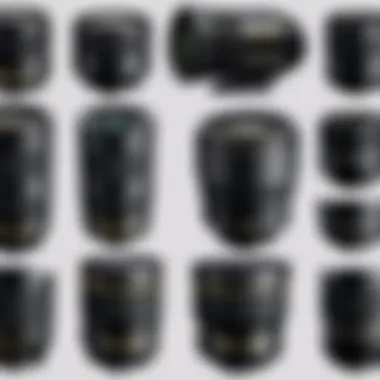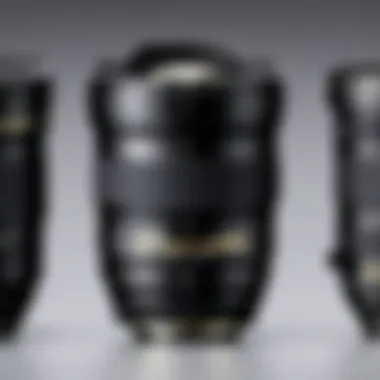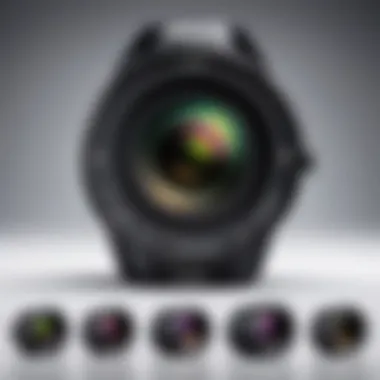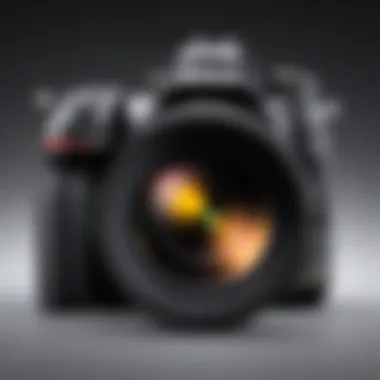Essential Lenses for Nikon Z5: A Detailed Guide


Intro
In today's photography landscape, the choice of lens can significantly affect the quality and style of your images. The Nikon Z5, a full-frame mirrorless camera, presents a platform that supports a diverse range of lenses. This article provides a detailed examination of the various lens options available for the Nikon Z5, focusing on specifications, performance, and suitable use cases.
Understanding the compatibility and performance of each lens is vital for both IT professionals and photography enthusiasts. This guide aims to demystify the lens selection process, giving readers the insights needed to make informed choices. Whether you are capturing landscapes, portraits, or dynamic action shots, the right lens can elevate your photography to new heights.
Hardware Overview
Specifications
When considering a lens for the Nikon Z5, one must first review its specifications to understand how they align with your photographic requirements. The physical build quality, optical performance, and compatibility with the Nikon Z5 system are all essential aspects. Each lens has unique specifications, including focal length, maximum aperture, and autofocus capabilities.
- Focal Length: Determines the angle of view and the level of zoom. Options range from wide-angle for landscapes to telephoto for wildlife.
- Maximum Aperture: Influences depth of field and low-light performance. A wider aperture allows for better performance in challenging lighting.
- Image Stabilization: Reduces the blurriness from camera shake, particularly useful in longer focal lengths.
Performance Metrics
Performance metrics, including sharpness, color rendition, and bokeh quality, can vary significantly between lenses. Testing these metrics helps in determining which lens suits specific shooting scenarios.
- Sharpness: Evaluates how well the lens renders detail. For landscape photographers, a sharp lens is crucial.
- Color Rendition: Affects how colors appear in your images. Some lenses may exaggerate certain colors, which is useful for specific styles.
- Bokeh Quality: Important for portrait photography, as a pleasing blur of the background can isolate the subject effectively.
"Choosing the correct lens is as important as selecting the right camera. The lens shapes the final image, much like a painter chooses brushes for their work."
Lens Options for Nikon Z5
As we proceed through this guide, we will categorize the lens options into several groups based on their types and uses. Each category will feature lenses suited for particular photographic styles, allowing for a more nuanced approach to lens selection.
Prolusion to the Nikon Z5
The Nikon Z5 is positioned as an entry-level full-frame mirrorless camera, which appeals to both amateurs and serious enthusiasts. It serves as a bridge for those moving from crop-sensor formats to full-frame imaging capabilities. Understanding the Z5's specifications and key features is crucial, especially for professionals considering the versatility of lens options that complement its renowned performance.
Specifications Overview
The specifications of the Nikon Z5 are impressive for a camera in its class. It includes a 24.3-megapixel full-frame CMOS sensor, which offers high-resolution images with excellent detail. The ISO range extends from 100 to 51,200, ensuring acceptable image quality even in low-light conditions. This flexibility in ISO settings makes the Nikon Z5 suitable for various photography scenarios, from landscapes to portraits.
Furthermore, it supports 4K video recording. The camera can capture 4K video at 30 frames per second, making it a suitable choice for videographers rather than traditional DSLRs. The compact design of the Z5, combined with robust weather sealing, enhances its portability and durability, especially for outdoor use.
Key Features
The Nikon Z5 boasts several key features that set it apart. One of the most notable is its dual card slots, which provide redundancy and ample storage options. This is essential for professional work, where saving every moment is crucial.
Autofocus is another impressive aspect, equipped with a hybrid AF system that uses 273 focus points. This offers fast and accurate focusing, which is beneficial in a variety of shooting conditions.
Another feature worth mentioning is its in-body image stabilization, which helps reduce camera shake. This capability improves handheld shooting, particularly in low-light settings or when using longer lenses.
The Nikon Z5 combines practicality with advanced technology, creating a compelling option for photographers seeking quality and versatility.
In summary, the Nikon Z5's specifications and features establish a strong foundation for understanding its lens compatibility. These elements significantly influence the selection of lenses tailored to fit diverse photographic requirements, which will be explored further in the subsequent sections.
Understanding Lens Compatibility
Understanding the lens compatibility for the Nikon Z5 is crucial for photographers seeking to optimize their image-making experience. Each lens type offers unique characteristics that influence your photographic style, technique, and results. This section explores the fundamental components of lens compatibility, focusing on the lens mount system and how it integrates with both full frame and APS-C lenses.
Lens Mount System
The Nikon Z5 employs the Nikon Z mount system, a significant advancement over its predecessors. This mount features a large diameter of 55mm and a short flange distance of 16mm. The wider mount allows for better light transmission and more design flexibility, facilitating the incorporation of advanced optical technologies.
Photographers benefit from a diverse selection of native lenses, specifically engineered for the Z mount. These lenses optimize performance, particularly in autofocus capabilities and low-light conditions. Additionally, the lens mount system is compatible with F mount lenses through the FTZ (F to Z) adapter. This compatibility gives users access to a broader range of Nikon lenses, enhancing usability without limiting choice.


Key benefits of the Nikon Z mount system include:
- Enhanced optical performance due to advanced design.
- Compatibility with a vast array of F mount lenses using the FTZ adapter.
- Improved versatility for both professional and amateur photographers.
Full Frame vs. APS-C Lenses
An essential consideration in lens compatibility is the distinction between full frame and APS-C lenses. The Nikon Z5 is a full-frame camera, meaning it is designed to leverage the advantages of full frame lenses, which generally provide superior image quality across the frame. Full frame lenses also tend to have wider apertures, allowing for better performance in challenging lighting conditions and enabling creative effects like shallow depth of field.
In comparison, APS-C lenses are designed for smaller sensors and generally produce a cropped field of view. While they may be more budget-friendly and lightweight, they may not deliver the same level of quality when mounted on a full-frame camera like the Z5. Mounting these lenses on the Z5 may also result in a crop factor, further affecting the lens's effective focal length.
"Choosing the right lens based on sensor compatibility is fundamental to achieving the desired photographic outcomes."
Factors to consider when deciding between full frame and APS-C lenses:
- Image Quality: Full frame lenses typically provide better sharpness and detail.
- Depth of Field: Full frame lenses allow for more creative control over depth of field.
- Weight and Size: APS-C lenses may be lighter and more compact, suitable for travel.
Types of Lenses for Nikon Z5
Understanding the types of lenses available for the Nikon Z5 is crucial for anyone eager to maximize the camera's potential. Each type of lens serves distinct purposes, enabling different styles of photography. Choosing the right lens is not merely about fitting it onto the camera; it affects composition, perspective, and the overall image quality. With the Nikon Z5, photographers can explore various creative avenues based on their specific needs, whether that’s capturing grand landscapes or intimate portraits.
Standard Zoom Lenses
Standard zoom lenses, such as the Nikon Z 24-70mm f/4 S, offer versatile focal lengths, making them an excellent choice for various shooting environments. These lenses cover a range of common photographic scenarios, giving a good balance between wide-angle and telephoto capabilities. Photographers often favor them for their convenience; users can quickly adjust zoom without needing to switch lenses, which can save time during shoots. The consistent f/4 aperture also ensures decent low-light performance while maintaining a compact design. Standard zoom lenses serve as reliable companions for everyday photography, suitable for everything from family gatherings to travel shots.
Prime Lenses
Prime lenses like the Nikon Z 50mm f/1.8 S provide distinct advantages by offering fixed focal lengths. This limitation often results in sharper images with better light-gathering abilities due to wider apertures; prime lenses generally excel in low light conditions. The simplicity of using a prime lens encourages photographers to engage more with their composition, which can lead to more thoughtful image creation. Their often lightweight and compact form also adds to their appeal, particularly for portrait and event photography.
Wide-Angle Lenses
Wide-angle lenses, such as the Nikon Z 14-30mm f/4 S, expand the creative possibilities for photographers interested in landscapes, architecture, and group shots. These lenses capture a larger field of view, allowing users to include more elements without stepping back. This characteristic is beneficial in tight spaces or when photography vast scenes. Their capability to create interesting perspectives can lead to more dynamic images. Distortion can be a concern with wide-angle lenses, but many modern designs minimize this issue, helping to maintain the natural look of the subject.
Telephoto Lenses
Telephoto lenses like the Nikon Z 70-200mm f/2.8 VR S are essential for wildlife and sports photography, allowing photographers to capture distant subjects without sacrificing image quality. These lenses excel in isolating the subject from the background, creating visual impact through compression. The fast shutter speeds they enable also aid in freezing motion, which is vital in fast-paced environments. The versatility of telephoto lenses can be strategic; they are useful for candid portraiture as well. The longer reach makes them practical for various situations.
Macro Lenses
Macro lenses, such as the Nikon Z MC 50mm f/2.8, open a world of detail in close-up photography. These lenses are engineered to produce high-quality images at very close distances, which is ideal for capturing the intricate features of flowers, insects, and smaller objects. A macro lens is not just a tool for budding entomologists; it opens the door to creative explorations in texture and form. They often feature focus stacking capabilities, enhancing the depth of field for an even greater professional touch.
Understanding the characteristics and advantages of different lens types is vital when shooting with the Nikon Z5. This knowledge helps refine the user's skill and enriches the photography experience.
Top Recommended Lenses for the Nikon Z5
Selecting the right lens for the Nikon Z5 is critical to maximizing its capabilities, especially when considering the performance and diverse situations that photographers encounter. This section delves into top recommended lenses specifically designed for the Nikon Z5, emphasizing their unique features, advantages, and suitability for various photographic needs. Understanding these lenses will not only enhance your photographic experience but also empower you to make informed decisions related to your craft.
Nikon Z 24-70mm f/ S
The Nikon Z 24-70mm f/4 S is a versatile and highly regarded lens that offers a constant aperture of f/4 throughout its zoom range. This lens is ideal for various photography styles, from landscapes to portraits. Its compact and lightweight design enhances portability, which is beneficial for on-the-go shooting. Additionally, the lens employs advanced optical technology to minimize chromatic aberrations, providing sharp images even at wide apertures.
"The Nikon Z 24-70mm f/4 S lens combines performance with convenience, making it an essential tool for those looking to capture high-quality images across multiple scenarios."


Nikon Z 50mm f/1. S
Next, the Nikon Z 50mm f/1.8 S lens excels in low-light conditions due to its wide aperture. It creates beautiful bokeh, enhancing portrait photography by isolating subjects with excellent depth of field. The lens construction includes high-quality glass elements, contributing to its impressive sharpness. Photographers will appreciate its compact size and lightweight nature, which make it a practical choice for everyday use. This lens offers a perfect balance between performance and affordability, catering to both enthusiasts and seasoned professionals.
Nikon Z 14-30mm f/ S
For those who gravitate towards wide-angle photography, the Nikon Z 14-30mm f/4 S stands out. This lens is particularly suited for landscape and architectural photography. The constant f/4 aperture across the zoom range ensures consistent exposure while offering flexibility in framing your shots. It also features a compact form factor, which is noteworthy for a wide-angle lens. The optical design minimizes distortion, making it ideal for capturing expansive scenes without unwanted artifacts.
Nikon Z 70-200mm f/2. VR S
The Nikon Z 70-200mm f/2.8 VR S lens is a powerhouse for those who require telephoto capabilities. Perfect for sports and wildlife photography, its fast f/2.8 aperture allows for excellent subject isolation and low-light performance. This lens incorporates advanced vibration reduction technology, helping to stabilize images, which is crucial when shooting at longer focal lengths. The build quality is robust, providing durability in various shooting environments. Photographers looking for versatility and performance will find this lens to be an exceptional choice.
Nikon Z 50mm f/2.
Finally, the Nikon Z MC 50mm f/2.8 is the go-to option for macro photography. Its close focusing capability allows for intricate details to be captured beautifully. This lens offers sharp images with high contrast, making it ideal for subjects such as flowers and small objects. The compact and lightweight nature of the MC 50mm f/2.8 allows for easy handling when shooting in the field. Its accessibility to a broader range of photographers, along with its notable performance, solidifies its place as a recommended lens for the Nikon Z5.
In summary, each lens presented in this section has its unique strengths and ideal use cases. Whether one opts for the versatility of the Nikon Z 24-70mm f/4 S or the precision of the Nikon Z MC 50mm f/2.8, selecting the right lens can significantly enhance the photographic experience.
Understanding Lens Specifications
Understanding lens specifications is essential for photographers, particularly when using the Nikon Z5. This knowledge allows one to evaluate different lenses based on their technical details, which directly affects image quality and usability. Specific elements like aperture range, focal length, and autofocus capabilities are critical in determining the best lens for various photographic scenarios. By grasping these specifications, individuals can make smarter decisions that align with their photographic style and requirements.
Aperture Range
The aperture range of a lens is fundamental for controlling exposure and depth of field. This measurement, usually represented as an f-number (e.g., f/1.8, f/2.8), reveals how much light the lens can let in. A lower f-number indicates a wider aperture, allowing more light to reach the sensor. This is particularly advantageous in low-light situations or when capturing fast-moving subjects.
For the Nikon Z5, lenses with a wide aperture are preferred for portrait photography, as they provide a pleasing bokeh effect with a blurred background. On the other hand, lenses with a higher f-number can be beneficial for landscape photography, offering greater depth of field for sharpness across the image.
Focal Length
Focal length determines the lens's perspective and how much zoom is available. It is measured in millimeters and influences the composition and framing of a shot. For instance, a wide-angle lens, such as a 14-30mm, is excellent for capturing landscapes or architecture. In contrast, a telephoto lens, like a 70-200mm, is more suitable for wildlife photography or portraits from a distance.
Knowing the focal length helps in understanding the lens's suitability for specific tasks. Whether one needs to create dynamic wide shots or intimate close-ups, the choice of focal length significantly alters the outcome of the photograph.
Autofocus Capabilities
The autofocus capabilities of a lens play a crucial role in modern photography, including that of the Nikon Z5. High-performance autofocus systems can quickly and accurately focus on subjects, improving the chances of capturing sharp images. Lenses equipped with advanced autofocus mechanisms tend to deliver better performance in dynamic situations, such as sports events or nature photography.
Nikon Z5 users should consider lenses with silent and fast autofocus features for video recording as well. This helps in maintaining smooth transitions and minimizes distractions during shooting, contributing to overall production quality.
In summary, understanding lens specifications—aperture range, focal length, and autofocus capabilities—empowers photographers to make informed decisions. This knowledge addresses individual needs and maximizes photographic potential.
Factors to Consider When Choosing a Lens
Selecting the right lens for your Nikon Z5 is not a mere decision; it influences how you capture images and the types of photography you can pursue. Several factors will determine the most suitable lens for your needs. Understanding these elements can make a significant difference in your photographic journey.
Photographic Needs
When choosing a lens, assess your photographic goals. Different types of photography, such as portrait, landscape, or macro, require specific lens characteristics. For instance, portrait photography typically benefits from fast primes like the Nikon Z 50mm f/1.8 S, which can create a pleasing bokeh. On the other hand, landscape photography favors wide-angle lenses like the Nikon Z 14-30mm f/4 S, allowing you to capture expansive scenes.
Additionally, consider the shooting conditions. If you frequently shoot in low-light environments, lenses with larger apertures are beneficial. They allow more light, resulting in clearer images. Understanding your personal photography style and objectives is crucial in lens selection.


Budget Constraints
Budget is an unavoidable consideration. Quality lenses can vary greatly in price. It is important to allocate your resources wisely. Expensive lenses often offer better optics, durability, and features, which can enhance your photography. However, several budget-friendly options like the Nikon Z 24-70mm f/4 S provide excellent performance without breaking the bank.
To maximize your budget, evaluate used or refurbished lenses. They can serve as a cost-effective alternative while maintaining quality. Prioritize what you need most in a lens and plan accordingly to ensure that your investment aligns with your photography aspirations.
Portability and Weight
Another key factor is the lens's portability and weight. If you travel frequently or attend events, a lightweight setup can be advantageous. Bulkier lenses can be difficult to carry for extended periods. The Nikon Z MC 50mm f/2.8, for example, is compact and easy to manage, making it suitable for on-the-go shooting.
When considering portability, balance is essential. A smaller, lighter lens may sacrifice some optical performance. However, many photographers find the convenience of a lightweight setup worth the trade-off. Take into account your typical shooting scenarios to identify which lenses will provide the optimal balance of performance and portability.
Key Points to Remember:
- Define your photographic needs first.
- Assess your budget before purchasing.
- Consider the portability related to your lifestyle.
Your ability to evaluate these factors will empower you to make a more informed choice when selecting a lens for your Nikon Z5, aligning with your photography passions.
Maintaining and Caring for Lenses
Maintaining and caring for lenses is crucial for photographers who want to get the best results from their Nikon Z5. Lenses are delicate instruments that can be easily damaged if not treated properly. Proper care can ensure longevity and optimal performance. Photographers should pay attention to cleaning, storage, and general handling of the lenses. The benefits of good maintenance not only protect the investment but also contribute to consistent image quality. Neglecting these aspects can lead to decreased performance and can tarnish the photographic experience.
Cleaning Techniques
Cleaning lenses is essential to preserve their performance. Dust, fingerprints, and smudges can severely affect image quality. Here are steps to follow when cleaning lenses:
- Use a blower: Start by removing loose dust or debris with a blower. This is often the safest method to avoid scratches.
- Microfiber cloth: Use a clean microfiber cloth to gently wipe the lens. Move in a circular motion from the center outwards to reduce the risk of streaks.
- Lens cleaning solution: If smudges remain, apply a few drops of lens cleaning solution to the cloth, not directly on the lens. This method ensures you do not oversaturate the lens surface.
- Repeat if necessary: In case stubborn marks persist, repeat the cleaning process carefully.
One should take caution to avoid using household cleaning products, as they can damage the lens coating. Also, never clean the lens when it’s dirty unless absolutely necessary, as this can cause scratches.
"A clean lens is a happy lens. It consistently delivers clearer images and performs as expected."
Storage Recommendations
Proper storage is vital to maintaining lens condition and functionality. Here are key points for effective lens storage:
- Lens caps: Always use both the front and rear caps when the lens is not in use. This provides essential protection against dust and impacts.
- Dry environment: Store lenses in a dry place. Excess moisture can cause fungus growth, which is difficult to remove.
- Lenses case: Utilize a padded case or bag for added protection. This helps shield the lenses from accidental drops and external pressure.
- Avoid extreme temperatures: Store lenses away from extreme heat or cold. High temperatures can damage coatings and seals.
Closure
The conclusion plays a pivotal role in summarizing and reinforcing the main points of the article regarding lenses for the Nikon Z5. It allows readers to reflect on the various aspects of lens selection and its significance in enhancing photographic outcomes. The article's insights into compatibility, specifications, and the diverse types of lenses available for the Nikon Z5 are essential for making informed decisions.
Importance of Lens Selection
Choosing the right lens directly influences the quality of images captured. When photographers understand the implications of focal lengths, aperture sizes, and types of lenses, they can adapt their approach to different photographic environments, whether capturing landscapes, portraits, or macro subjects.
Specific Elements to Consider
Several factors must be considered when finalizing lens choices:
- Photographic Needs: Understanding what type of photography you indulge in helps streamline the decision-making process. For example, travel photographers may prioritize portability while opting for standard zooms.
- Budget Constraints: High-quality lenses often come at a premium price, but knowing the budget can help narrow down options effectively.
- Portability and Weight: Especially for long travels or outdoor shoots, the weight and size of lenses become crucial.
Benefits of Proper Lens Selection
When these elements are carefully weighed, photographers can access numerous advantages:
- Enhanced image quality through the use of appropriate lenses.
- Greater creative control over depth, focus, and framing.
- Increased versatility in diverse shooting situations.
Ultimately, the right lens is more than just a tool; it is an critical component that can define the photographer's voice and vision. This conclusion encapsulates the significance of thoughtful lens selection for aspiring and professional photographers alike. By synthesizing the knowledge shared throughout the article, readers are empowered to elevate their photographic journey.



